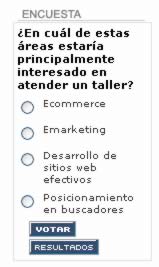Written by Fernando Maciá
Index
- What is it about our website that makes it more attractive than traditional market research?
- Three examples of how to turn our web page into a market research study
- Keywords used in search engines for content pages: following the footprint of those who have looked at the showcase and those who have entered the store.
- Web site surveys: finding out why people visit and buy
- Conclusion
Market research is one of the mandatory steps in any business plan. A good market survey outsourced to specialized companies can be costly and a market survey conducted by ourselves can have large sampling errors. The development of a page for the purpose of gathering market information can be a middle ground that overcomes the disadvantages of either of the two previous paths.
Marketing is about satisfying our consumers as well as possible. Therefore, the first step is to understand their buying habits.
Any system or tool that portrays this information is the most valuable asset to start a company, line of business or product.
Knowing our consumers involves market research. Depending on the amount of the investment, the services of an expert market research firm may be hired or, if resources are scarce, the entrepreneur may infer the characteristics of the market based on limited data collected by him.
A market study using our website as a platform can overcome the disadvantage of the high costs of hiring a qualified supplier and the disadvantage of using insufficient data or inappropriate methodologies.
What is it about our website that makes it more attractive than traditional market research?
a) Our web page is open 24 hours a day and 365 days a year, that is, we have a pollster working longer and consequently we can obtain a larger sample in a shorter period of time.
b) The tabulation or processing of the information collected through our website is faster than if we compare it with a traditional market study. It is even possible to obtain information already tabulated and filtered in real time.
c) Its cost is low and economies of scale are applicable. Sometimes a market study based on our website for 1000 unique visitors can cost the same as for 5000 unique visitors. In the off-line world, the cost of market research varies depending on the size of the sample.
d) The possibility that the responses are conditioned to the influence of the interviewer is practically nil in the case of web pages.
Three examples of how to turn our web page into a market research study
Internal search engines in real estate portals: following the footprint of visitors who have stayed in the store.
The internal search engines within a real estate portal is a form on the home page that asks us what type of property we are looking for. The form is filled in by making a selection from a series of options presented by the search engine itself. Among these parameters are the city, the neighborhood, the type of property, the number of rooms and the maximum price willing to pay.
All this information is stored in a database and by means of a small amount of programming, an interface can be created that provides us with the summary of results aggregates from the use of this search engine in such a way that they answer some questions such as: What are the most demanded areas, what type of properties are most in demand in a certain city, what is the average price that people are willing to pay in a certain neighborhood for a penthouse, etc.
Just as real estate portals use this type of disguised surveys, it is advisable to place an information search interface on your website. In addition to improving the usability of the website, it is a source of valuable information for your business.
Keywords used in search engines for content pages: following the footprint of those who have looked at the showcase and those who have entered the store.
If the good content is the poetry with which most web visitors are conquered, our concern in the future will be to find out which words will continue to make future users fall in love with my website. Many times the content department of a portal is short of inspiration and a quick and effective market research can bring back the muse to the writers.
A good web traffic statistics system will tell us (if the site is well positioned in search engines) the combination of words with which all my visitors are arriving. If we analyze this extensive list of words and phrases, we will realize that there are thematic areas that have not been fully satisfied by our content. From this analysis we can identify content opportunities.
For example, if I have a law firm specialized in the Organic Law of Data Protection (LOPD), and I observed through my web statistics system that I get many visits through the keywords “LOPD sanctions”, “LOPD fines”, “what happens if you do not comply with the LOPD”; I can easily deduce that if I write an article or a tutorial explaining in detail the sanctions that derive from the breach of the LOPD, the number of visits and page views of my website will increase.
The keywords that bring visits to my website is the most significant indicator to know the buying habits of my potential customers. This information can be complemented with other web statistics such as city or country of origin of the visit, time of the visit, search engine or web page that originated the visit, etc. Statistical programs quantify a large amount of information; our job is to identify the relevant market indicators for our business.
Web site surveys: finding out why people visit and buy
Online surveys are one of the most underused and underappreciated research methods on the Internet. This reality is due to the belief that with the measurement of web statistics all the variables are already registered. Online surveys measure a number of additional parameters that web traffic statistics systems cannot measure.
For example, we may know through our web traffic systems that 50% of our visitors abandoned the shopping cart without completing the purchase process, but we don’t know if they were able to complete the purchase process. helps us to understand the reasons The main reasons for abandonment: did they leave the site because they had a technical problem, did they not understand the purchase mechanism or process, were they missing some information, were they just looking around, etc. Possibly an online questionnaire can answer some of these questions.
The success of an online survey depends on where and when it is presented and the format of the survey.
As for the place and time to present a survey, the most effective ones are those we find at the end of a good article, next to a relevant news item, at the end of an interesting post in a blog, etc. On the contrary, a survey represented by an intrusive pop-up that occupies the entire page or that cannot be seen because the user has a pop-up blocker installed is not the best way to obtain relevant information from our consumers.
Users are willing to provide information if they have previously received some benefit.
In terms of formatting, anything that leads to a simple selection question that can be answered with the left mouse button is the best way to achieve our objectives. At this point, if we can add the possibility that the user can see the results in real time, it gives an additional push for the group of users who are still undecided to end up expressing their opinion.
Conclusion
The first and most important step in turning our website into an excellent market research tool is to establish our objectives that is to say, to be very clear about what we want to measure, what we want to know. Depending on the answer to this question, we will use some tools to the benefit of others. Even in this area we must segment the objectives, since the objectives of the marketing department may be very different from the research objectives of the finance department.


